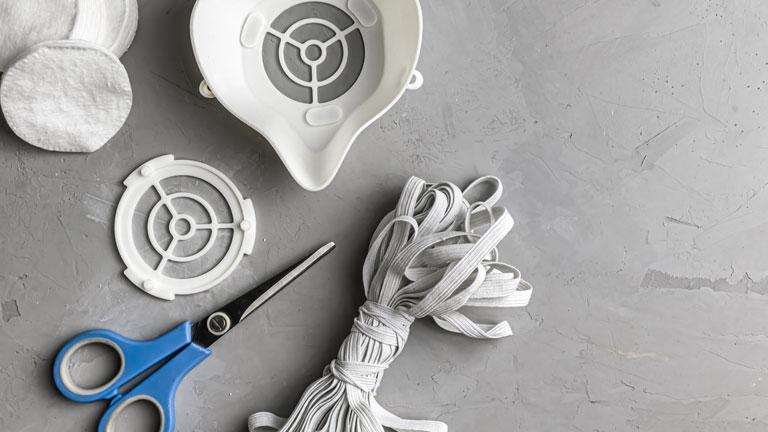RAPID + TCT started this post as an update for our event attendees and exhibitors to talk about the wonderful things happening across 3D printing in medicine that we learned about while coordinating for the in-person event in Anaheim. That is still important.

However, with the outbreak of COVID-19, we shifted gears slightly to incorporate a few of the amazing initiatives taking place as we battle this pandemic. You may find that you would like to lend your expertise and equipment on the front lines so we provide links to these 3D printing in medicine initiatives. Here are just a few that we have been tracking, from face shields to door handles:
HP Inc., with its Multi Jet Fusion (MJF) 3D printers as well as numerous network partners, can leverage over 1,000 printers to serve this need. The special page on 3D printing solutions to battle COVID-19 showcases some of the parts that have been printed and distributed to local hospitals. HP and its partners have made several 3D COVID-19 models free to download here.
HP partner and well-known digital manufacturing software and platform provider, Materialise, is providing its own models for the COVID-19 initiative, including the hands-free 3D-printed door opener, plus a shopping cart handle (free).
Formlabs is using its 250-plus in-house 3D printers at its Ohio-based printing facility to produce around 100,000 COVID-19 test swabs per day. The swabs are being used on patients at hospitals and health providers across the country experiencing test kit shortages, including New York’s largest hospital system, Northwell Health, and Tampa General Hospital, to help ramp up testing.
Universities and public makerspaces are getting involved with 3D Printing in Medicine:
At Tennessee Tech University, Dr. Ismail Fidan, a longtime SME member and advocate, has fired up over 30 printers as he and his team provide the Prusa Research RC2 face shield design to Tennessee state officials distributing the shields to area healthcare professionals. The University is leveraging the NSF-funded Additive Manufacturing Coalition and Hub on campus to turn the makerspace, STEM center, and two department labs into 24/7 3D print facilities for the COVID-19 protective gear. They have made hundreds of masks and show no signs of slowing down.
On the other side of the United States, a community organization in Portland, Oregon, the Portland 3D Printing Lab, has been working diligently to customize Prusa Research RC2 Face Shields (open source design) for medical professionals in their city.
More Hardware providers and Distributors are serving the 3D Printing needs for PPE (personal protective equipment)
MatterHackers, the largest distributor of desktop digital manufacturing equipment and materials in the USA, created an initiative called the COVID-19 Additive Manufacturing Community Response Hub to connect those who need 3D printed medical equipment with those who can create it and make it. In just a matter of days, hundreds have signed up on both sides.
Another of additive manufacturing’s heavy hitters, Stratasys, has set up a page responding to the COVID-19 crisis. They are also supporting the CoVent-19 Challenge, which is an open innovation effort hosted by residents from Massachusetts General Hospital with a goal of designing a mechanical ventilator for this and future pandemics.
The Desktop Metal COVID-19 page is “offering medical equipment manufacturers and those making critical medical parts, access to our technology and engineering resources in order to provide free 3D printing services.”
Carbon is producing face shields (as an open source STL design file) as well as patient sampling swabs, but most notably, is providing access to their powerful Lattice Engine Software, for use beyond their own machines, during this COVID-19 crisis. 3D printed lattice structures can dramatically reduce material usage, speed print times, and improve comfort and performance for both patients and healthcare workers.
Last, for now, is one of the best-known small companies in the desktop 3D printing world — Prusa Research, started by Josef Prusa. He saw that people were starting to test out different ideas to try and help healthcare workers with personal protective equipment and determined that a better face shield would be the best option. He put out a design to his community of thousands of printer owners and within days started iterating on a strong design (and is still iterating). You can download the design with instructions and files: Prusa Protective Face Shield – RC2. Tens of thousands of these are in motion on printers of all types around the world and getting distributed just as quickly.
One thing is certain, 3D printing software, hardware, and distributors are rising to the call to action raised by the pressing needs of our healthcare workers. As the Coronavirus (COVID-19) rages, RAPID + TCT supporters and partners are doing their best to help stem that tide. If you are willing to lend your expertise or already are doing so, let us know how you are serving those on the front lines of COVID-19. We would love to hear it for a future post.
Written by: TJ McCue
Here are several other media resources for you with private and public projects:
How 3D printing companies are responding to the coronavirus crisis at TCT Mag.
3D Printing Community Responds To COVID-19 and Coronavirus Resources at 3D Printing Industry.
You can read the full original on Forbes: Calling All Makers With 3D Printers: Join Critical Mission To Make Face Masks And Shields For 2020 Healthcare Workers.
